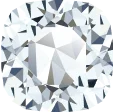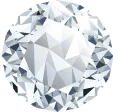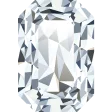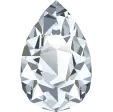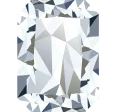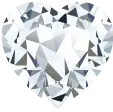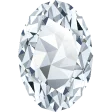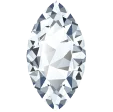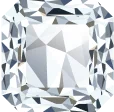Diamond Knowledge Center
Metal Knowledge Center
Gemstone Knowledge Centre
Jewelry Knowledge Center
Glossary of Terms
Diamonds can be cut in many different shapes, each having its own unique qualities. Given that shape is mostly a matter of taste, it is essential to identify with the attributes of each so that you make the right choice while purchasing. Majority of people perceive the classic diamond, as a round gem that has a fiery sparkling white brilliance and dazzling facets which allure the eye. It is the diamond cutter's art by which he carves these crystals into gems of magnificent and fanciful beauty. Skill of the cutter can create a diamond that is supreme in size with maximum brilliance and has least number of flaws. The outlines and contours of a loose diamond have a considerable impact on its appearance. From the ancient times round diamonds have been the most popular, but in recent times modern consumers have shown preference to other alternative shapes also, which include emerald, princess, radiant, and asscher cut diamonds
At Fascinating Diamonds®, we proffer the twelve most popular shapes in the jewelry industry today. Each shape is unique and in, its origin, traits (popularity), aesthetic properties (ratio), and outlay.
The Astounding: Round Shape Diamond
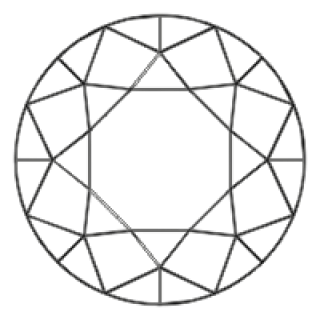
Origin
The round shape diamond came into existence in 1919 with the publication of Marcel Tolkowsky's thesis "Diamond Design”. Tolkowsky's work described the perfect proportions of a round cut diamond for maximizing light return (or brilliance) and dispersion (or fire). Its 58-facet cut, divided among its crown (top), girdle (widest part) and pavilion (base), is regulated through a precise formula to achieve maximum fire and brilliance.
Popularity
The round brilliant cut diamond is by far the most popular shape available today. This shape is a benchmark for all other diamond shapes, and accounts for more than 75% of total diamonds sold today. Round cut diamonds are ideally set in prongs, tension set, and bezel setting, as they add to the look of the diamond. Also, ample number of similar sized small round diamonds crafted in pavé setting or flush setting makes for an impeccable anniversary bands or engagement rings.
Celebrities Wearing Round Cut Diamond
Christina Aguilera, Scarlett Johansson, Natalie Portman, Britney Spears, and Gisele Bundchen are some of the celebrities to have adorned the beautiful round cut diamond.
Ratio
Every diamond shape has a length-to-width ratio, which concludes as to how a diamond will come into view from above. When opting for a round shaped diamond, look for a length-to-width ratio between 1 and 1.02. At Fascinating Diamonds® we lay stress on precision in measuring a diamond, as well as the length to width ratio, so that you know the exact shape of the round cut diamond engagement rings that you are considering
Cost
On a per carat basis round diamonds cost more than any other fancy shapes for two reasons higher demand and relatively low yield. As most of the rough stone is lost in cutting a round diamond, the cost of each carat held is higher. Celebrated for its unmatched fire and brilliance, this cut swanks outstanding light refraction properties, making it appear brighter than other shapes. A round diamond is more valuable than the other alternative shapes available, if it is of equal clarity and color.
Depth
| Depth (%) | Table (%) | |
|---|---|---|
| Excellent | 59 - 62.3 | 53 - 58 |
| Very Good | 58 - 58.9 or 62.4 - 63.5 | 52 - 53 or 58 - 60 |
| Good | 57.5 - 57.9 or 63.6 - 64.1 | 51 or 61 - 64 |
| Fair | 56.5 - 57.4 or 64.2 - 65 | 50 or 65 - 69 |
| Poor | < 56.5 or > 65 | < 50 or > 69 |
The Royal: Princess Cut Diamond
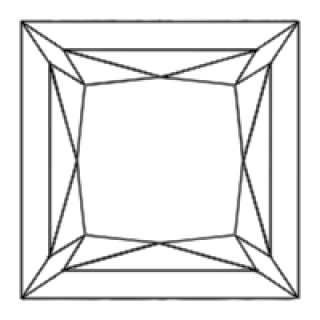
Origin
The princess cut diamond, is a square stone with 90-degree corners and has an assortment of abstruse facets that augment the diamonds intrinsic sparkle. Believed to be originated in the United States in 1980 this shape is one of the most proficiently produced types of diamonds, with nearly 60% of the original rough conserved during the cutting process. From all the other square cuts, the brilliant princess cut comes closest to accomplish the fire and brilliance of a round diamond, making it a perfect combination of gleaming appearance, unique shape, and virtual price value. A princess Cut diamond in general has 76 facets, giving it more brilliance and fire than the round cut diamonds.
Popularity
It is a comparatively new cut and made use in making solitaire engagement rings. This cut is most flattering to a hand with long fingers, most of the times it is inflated with triangular stones at its sides. Owing to its design, this cut needs more weight to be directed towards the diamond's depth in order to maximize brilliance. When searching for a more contemporary style, consider this cut, which is the second most popular shape after round cut. One of the valuable qualities of a princess cut diamond is that the existing inclusions are less noticeable due to its unique cutting and polishing technique, thus making it a favorite for engagement rings.
A princess cut diamond should ideally be cast in prong setting, which protects the four corners (the most likely spot for chipping). Since these corners were once close to the outer edge of the rough stone, flaws such as naturals, extra facets, and other inclusions may be found here. So when the corners are covered by the prongs, these flaws will be unseen once the diamond is set.
Celebrities Wearing Princess Cut Diamond
Star Jones, Penny Lancaster, Kendra Wilkinson, and Ali Larter are some of the celebrities to have adorned the beautiful princess cut diamond.
Ratio
When selecting a square shaped princess, look for a length-to-width ratio between 1 and 1.05. For those who prefer a rectangular shaped princess, choose a length-to-width ratio of 1.1 or greater. At Fascinating Diamonds® we lay stress on precision in measuring a diamond, as well as the length to width ratio, so that you know the exact shape of the princess cut diamond rings that you are considering.
Cost
Princess cut diamonds also are likely to have a slightly lower price-per-carat than round cut diamonds. The reason being that the four sided pyramid shape of the princess cut diamond is similar to one half of the octahedron rough stone from which it is cut. Due to this similarity two equally sized princess cut diamonds can be cut from the same rough stone with moderately less wastage (roughly 60% of the weight of the original rough stone is retained after cutting). Superior efficiency or yield automatically translates to a lower price.
Depth & Table
| Depth (%) | Table (%) | |
|---|---|---|
| Excellent | 64 - 75 | 62 - 70 |
| Very Good | 64 - 75 | 59 - 61 or 71 - 74 |
| Good | 58 - 63.9 or 75.1 - 80 | 56 - 58 or 75 - 82 |
| Fair | 56 - 57.9 or 80.1 - 84 | 53 - 55 or 83 - 85 |
| Poor | < 56 or > 84 | < 53 or > 85 |
The Revolutionary: Asscher/ Square Emerald Cut Diamond
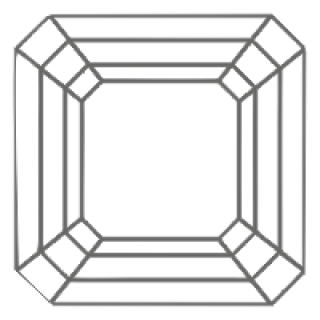
Origin:
The asscher or square emerald cut diamond was brought into existence in 1902 by the Asscher Brothers of Holland, the well-known diamond cutters from which this diamond got its name. This diamond shape makes use of many of the similar cutting techniques used for the square emerald cut. It is a stepped square cut, also called the "square emerald cut" and similar to an emerald cut, the Asscher cut also has cropped corners. What puts the Asscher cut apart are its distinctively angled and cropped corners, which are considered as an innovative concept in diamond cutting. Its pavilion (bottom) is cut with rectangular facets, which produces wider flashes of brilliance rather than fiery sparkles of light. The crown (top) of an asscher cut diamond has an open table, making flaws that of color/cut and inclusions more noticeable to the naked eye. A finely cut asscher comprises of 58 facets and appears to have concentric squares as you gaze down through the table; the result is the appropriate positioning of the pavilion.
Popularity:
Asscher cut diamonds originally peaked to popularity in the 1920's, and can recently be found only in antique jewelry shops. The remarkable Asscher cut induces an art deco feel. Around 2002, about a hundred years after the original asscher cut diamond was created, this shape began to make a comeback, stimulated by the cut modifications which gave this shape more brilliance than traditional asscher cut diamonds.
Celebrities Wearing Asscher Cut Diamond:
Until recently, very few jewelry stores carried asscher cut diamonds solitaire rings. But the Asscher cut has quickly gained recognition after it was featured on the television show "Sex & and the City" and stars like Kate Hudson, Jessica Alba, and Gwyneth Paltrow have adorned Asscher-cuts diamonds. Due to the enlarged popularity, many stores are now carrying this stylish cut.
Cost:
An asscher cut diamond is designed to draw the attention and it is said that, ideally one should always select the highest quality stone that can be afforded. In most cases premium price is associated with asscher cut diamonds at the higher end of the color scale. Due to its buyers for this cut want the color grades that range between D-F, and are prepared to pay a substantial prize to get them.
Depth & Table
| Depth (%) | Table (%) | |
|---|---|---|
| Excellent | 61 - 67 | 61 - 69 |
| Very Good | 59 - 60.9 or 67.1 - 70 | 57 - 60 or 70 - 72 |
| Good | 57 - 58.9 or 70.1 - 74 | 54 - 56 or 73 - 74 |
| Fair | 54 -56.9 or 74.1 -79 | 51 - 53 or 75 - 79 |
| Poor | < 54 or > 79 | < 51 or > 79 |
The Vintage: Radiant Cut Diamond

Origin:
The radiant cut diamond first became popular in the 1980's and thus is a relatively new cut in the jewelry industry. The distinctive cropped corner square shape of the radiant cut is a spectacular amalgam of a cushion and a princess cut, and for that reason looks stunning when set with round or square cornered diamonds. With an intricate 62 to 70-facet cut radiant diamonds emit remarkable brilliance. The most significant characteristic of this shape is its trimmed corners. It is best suited for people who appreciate the sophistication of emerald or asscher cut diamonds and fire of round diamonds. Another reason why radiant cut is highly sought-after is because it is designed to bring out maximum brilliance from the rough stone.
Square and Rectangle Radiant Cut Diamond:
The unique shape of the radiant cut is a striking fusion of a traditional round-cut and an elegant emerald-cut, resulting in a square, near-square, or rectangular orientation. The Square radiant cut diamond has a wholesome brilliant cut facet pattern that is applied to both the crown and pavilion, producing an effervescent and fiery square diamond. The rectangle radiant cut diamond comes with slightly cropped corners that give it an exceptional sparkle and fire.
Popularity:
This cut gaining popularity because of its flexibility. It basically combines the stunning brilliance of a princess cut with its many facets, and the square shape of an emerald cut or an asscher cut with its trimmed corners, to make up a truly exclusive and sparkling cut.
Celebrities Wearing Radiant Cut Diamond:
Jennifer Lopez, Drew Barrymore, Khloe Kardashian, and Jessica Biel are some of the celebrities to have adorned the beautiful princess cut diamond.
Ratio:
Every diamond shape has a length-to-width ratio, which concludes as to how a diamond will come into view from above. The length to width ratio ranging between 1 and 1.05 is ideal for the square radiant cut diamond rings; however for slightly rectangular cut diamond rings the ideal ratio of 1.15 or greater is recommended. At Fascinating Diamonds® we lay stress on precision in measuring a diamond, as well as the length to width ratio, so that you know the exact shape of the radiant cut diamond rings that you are considering.
Cost:
The radiant cut is relatively scarce and only appeals to those who are seeking a unique look. This rectangular radiant cut is an excellent option for buyers who like the combination of the geometrical lines of emerald shape and the sparkling brilliance of the round cut. In most of the cases premium price is associated with radiant cut diamonds at the higher end of the color scale. Customers want the D-F color grades, and are prepared to pay a substantial prize to get them.
Depth & Table
A poor symmetry maintained in the diamond misdirects the light entering it and make it appear dull. Diamonds with poor symmetry have flaws that can be easily detected under 10x magnification and are clearly visible to the naked eye.
| Depth (%) | Table (%) | |
|---|---|---|
| Excellent | 61 - 67 | 61 - 67 |
| Very Good | 58 - 60.9 or 67.1 - 70 | 58 - 60 or 68 - 70 |
| Good | 56 - 57.9 or 70.1 - 71 | 56 - 57 or 71 |
| Fair | 54 -55.9 or 71.1 -73 | 54 - 55 or 72 - 73 |
| Poor | < 54 or > 73 | < 54 or > 73 |
The Luminous: Cushion Cut Diamond
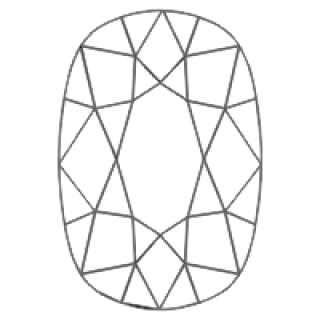
Origin
The cushion cut diamond is deep embedded in mining history and was earlier referred to as the old mine cut which was first introduced into the jewelry market in year 1830. The existence of this cut has been around for almost 200 years, and for the first century it was one of the most sought after diamond shape (similar to round cut today). Until the beginning of the 20th century, the cushion cut diamond was the de-facto diamond shape. It is a mix of square cut which has rounded corners, and with its 58 brilliant-style facets it bears resemblance to a pillow (hence the name). Most people consider it to be a softer version of the emerald shape when it is cut into a square or rectangular shape with rounded sides and corners. Owing to its character-rich traditional look, the cushion-cut diamond is desirable to those who prefer vintage-style rings and jewelry. Brilliant- or step-cut faceting fills up the cushion diamond with commendable brilliance.
Popularity
Until a few years back, it was hard to find cushion cut diamonds for sale outside estate sales and auctions. Nevertheless, antique cushion cut diamonds rings are enjoying a tiny rush in popularity as it has a strikingly passionate and classic look that without a doubt stands out from the crowd of round brilliants. Traditional cushion cut diamonds revert light in a bulky pattern than modern cuts. Combined with the inflated culet (which was considered pleasing for the pattern created when viewed through the table), this created a unique look that is valued today among dealers in antique diamond industry. Hence, many buyers are also attracted to the traditional feel pooled with modern performance offered by the cushion cut.
Celebrities Wearing Cushion Cut Diamond
Jennifer Garner, Ashley Judd, Naomi Watts, and Ivanka Trump are some of the celebrities to have adorned the beautiful princess cut diamond.
Ratio
Every diamond shape has a length-to-width ratio, which concludes as to how a diamond will come into view from above. The length to width ratio of 1.00 is ideal for the radiant cut diamond if it is square in shape; however they are often found in slightly rectangular shapes also and thus the ideal ratio of 1.10 to 1.20 is recommended for this type of cut. At Fascinating Diamonds® we lay stress on precision in measuring a diamond, as well as the length to width ratio, so that you know the exact shape of the cushion cut diamond rings that you are considering.
Cost
The values for cushion cut diverge more than most other shapes, and thus individual taste will dictate preferences. Though, normally less brilliant than round brilliant diamonds, cushion cut diamonds more often have superior fire, which is a part of their appeal. In most of the cases premium price is associated with cushion cut diamonds at the higher end of the color scale. Customers want the D-F color grades, and are prepared to pay a substantial prize to get them.{' '}
Depth & Table
| Depth (%) | Table (%) | |
|---|---|---|
| Excellent | 61 - 67 | 61 - 67 |
| Very Good | 58 - 60.9 or 67.1 - 70 | 58 - 60 or 68 - 70 |
| Good | 56 - 57.9 or 70.1 - 71 | 56 - 57 or 71 |
| Fair | 54 -55.9 or 71.1 -73 | 54 - 55 or 72 - 73 |
| Poor | < 54 or > 73 | < 54 or > 73 |
The Elegant: Emerald Cut Diamond
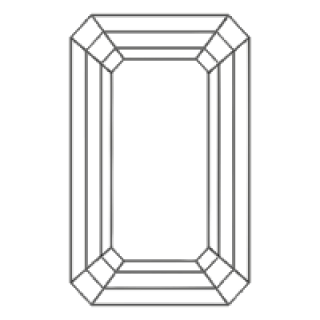
Origin
Emeralds have an exceptionally rich history that distinguishes them from other cuts. The word “emerald” comes from the ancient Greek word “green”. It is believed that in ancient Greece, emerald diamonds rings were used as strain relievers. Apparent by the name, "emerald cut" was initially developed for cutting emeralds, and not diamonds. It was designed for showcasing emeralds, which generally have more inclusions than diamonds, making emeralds more difficult to cut. The design was meant to address this flaw in emerald cutting but also grew popular for other gem stones, including diamonds. The emerald cut has 58 facets (25 pavilion, 25 crown, and 8 girdle), and eight sides as the four “corners” are actually short sides, too. Distinguished by beveled corners and step facets, this type of diamond is more transparent than other shapes, resulting in the need for higher standards of clarity. If an emerald-cut diamond is marked by an inclusion, it will be much more likely to be detected with the naked eye.
Popularity
This cut gained recognition as it has a timeless and elegant look. The rectangular cut, which has a relatively larger open table and fewer facets, highlights the clarity of the diamond more than any other shape. Emerald cut diamonds produce a hall-of-mirrors effect, with the interplay of light and dark planes .The trim lines of emerald cut diamonds lend a neat, sophisticated air to both the simplest and most elaborate ring setting. The unique look, long lines and dramatic flashes of light give the emerald cut a graceful appeal and hence make this cut so popular among masses.
Celebrities Wearing Emerald Cut Diamond
Angelina Jolie, Demi Moore, Eva Langoria, Beyonce, and Mariah Carey are some of the celebrities to have adorned the beautiful princess cut diamond.
Ratio
Every diamond shape has a length-to-width ratio, which concludes as to how a diamond will come into view from above. The ideal length to width ratio of 1.25 to 1.5 is recommended for this type of cut. At Fascinating Diamonds® we lay stress on precision in measuring a diamond, as well as the length to width ratio, so that you know the exact shape of the emerald cut solitaire diamond rings that you are considering.
Cost
Emerald cut diamonds varies from nearly square to a narrow rectangle. They are a popular choice among budget-conscious jewelry consumers seeking an economical alternative to pricier round or princess cuts. The more facets created by the diamond cutter, the higher its value will be.
Depth & Table
| Depth (%) | Table (%) | |
|---|---|---|
| Excellent | 61 - 67 | 61 - 69 |
| Very Good | 59 - 60.9 or 67.1 - 70 | 57 - 60 or 70 - 72 |
| Good | 57 - 58.9 or 70.1 - 74 | 54 - 56 or 73 - 74 |
| Fair | 54 -56.9 or 74.1 -79 | 51 - 53 or 75 - 79 |
| Poor | < 54 or > 79 | < 51 or > 79 |
The Majestic: Marquise Cut Diamond
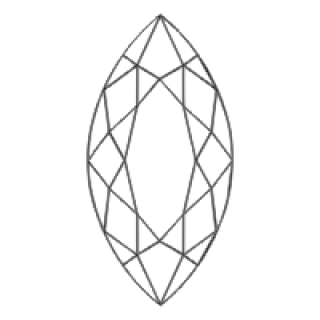
Origin
The marquise cut diamond or commonly known as football-shaped is truly stylish and timeless. The cut like its name has a very intriguing history. It was said that in France somewhere during the 18th century, King Luis XV ordered a diamond that was cut in such a way that it resembled the lips of Marquise de Pompadour who was his beloved. The cut that originated from this demand has now come to be called the marquise cut. At times jewelers refer to this cut as a Navette cut. This stretched out stone has pointed graceful ends that give it a dramatic look. As these diamonds are long and narrow, they also create an illusion of greater size. Carat for carat, the marquise diamond has one of the widest crown surface areas compared to any other diamond shape and it swanks a brilliant 58 facets, making it an ideal choice when trying to capitalize on the perceived size of a diamond.
Popularity
The marquise shaped diamond conveys drama with its brilliant cut and conical points at two ends. Because of its fascinating history marquise diamond engagement rings , are popular in masses. Rings set with marquise cut diamonds make the finger of the wearer look more slender. Skillfully, it also maximizes carat weight , giving the facade of a larger diamond than a round diamond of the same carat weight. A marquise cut diamond is striking on its own, but it also appears exquisite with other stones on either side of it. Most women admire a marquise cut stone because there are so many options available for setting it into a ring. A marquise diamond should always be set with prongs to guard the two points (the most likely spots for chipping). Because these points were once near to the outer edge of the rough stone, flaws such as naturals, extra facets, and other inclusions may be located here. Since the points are enclosed by prongs, these flaws will be unseen once the diamond is set.{' '}
Celebrities Wearing Marquise Cut Diamond
Catherine Zeta-Jones (set widthwise, 10-carat), Portia de Rossi, Queen Latifah (cuff, 100 carats total), and Victoria Beckham (set lengthwise, 3-carat).
Ratio
Every diamond shape has a length-to-width ratio, which concludes as to how a diamond will come into view from above. The ideal length to width ratio of 1.75 to 2.15 is recommended for this type of cut, but eventually it depends on personal taste and preferences when it comes to choosing how narrow or fat a marquise cut should be. At Fascinating Diamonds® we lay stress on precision in measuring a diamond, as well as the length to width ratio, so that you know the exact shape of the marquise cut solitaire diamond rings that you are considering.
Cost
The marquise diamond is shaped like a long, thin boat with a point at each end. Marquise cut diamonds need larger, or at least longer, rough diamonds compared to the round cut diamonds of similar carat weight. Marquise cut diamonds are more reasonably priced than other cuts of diamonds, which adds to their popularity as well. In the end, the price of this diamond depends upon the carat weight and color grades, for which the buyers are prepared to, pay a substantial prize to get them.
Depth & Table
| Depth (%) | Table (%) | |
|---|---|---|
| Excellent | 58 - 62 | 53 - 63 |
| Very Good | 56 - 57.9 or 62.1 - 66 | 52 or 64 - 65 |
| Good | 53 - 55.9 or 66.1 - 71 | 51 or 66 - 68 |
| Fair | 50 -52.9 or 71.1 - 4 | 50 or 69 - 70 |
| Poor | < 50 or > 74 | < 50 or > 70 |
The Timeless: Oval Shape Diamond
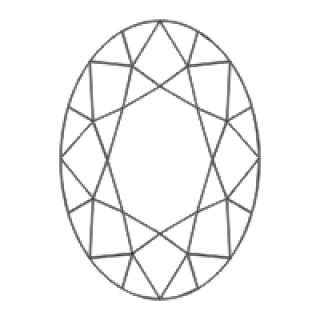
Origin
The oval shaped diamond was created by Lazare Kaplan in the 1960's and appeal to those who like their classics with a little edge. Cut with the same number of facets as a round diamond, an oval shape emits nearly the same level of brilliance and fire, and its elongated shape makes it appear larger in carat weight than a round. Timeless and classic, their elongated shape adds an interesting twist to rings and accentuates the hand to create a slender look. A typical oval brilliant diamonds have 56 facets.
Popularity
Oval shape is an ideal choice for a customer who likes the look of a round diamond, but wants something more unique. A beautiful cut that sparkles almost as brilliantly as a round brilliant cut, the oval diamond engagement rings are becoming a popular choice because they accentuate the fingers. Oval diamonds have the added advantage of an elongated shape, which can create the illusion of greater size. The slender shape can also make the finger of the wearer appear longer and slimmer, an effect often desired.
Celebrities Wearing Oval Cut Diamond
Katie Holmes, Salma Hayek, and Toni Braxton are some of the celebrities to have adorned the beautiful oval cut diamond.
Ratio
Every diamond shape has a length-to-width ratio, which concludes as to how a diamond will come into view from above. The ideal length to width ratio of 1.35 to 1.50 is recommended for this type of cut, but a slightly thinner cut may look more alluring in a setting where the diamond is edged by side stones. At Fascinating Diamonds® we lay stress on precision in measuring a diamond, as well as the length to width ratio, so that you know the exact shape of the oval cut diamond rings that you are considering.
Cost
An Oval cut is a brilliant egg-shaped diamond cut and usually looks larger from the “face up” position than other diamond shapes that have a similar carat weight. An oval-cut diamond is satisfying to most wearers, as it creates an illusion of a longer, more slender finger. Ultimately, the price of this diamond depends upon the carat weight and color grades, for which the clients are willing to pay a premium price.{' '}
Depth & Table
| Depth (%) | Table (%) | |
|---|---|---|
| Excellent | 58 - 62 | 53 - 63 |
| Very Good | 56 - 57.9 or 62.1 - 66 | 52 or 64 - 65 |
| Good | 53 - 55.9 or 66.1 - 71 | 51 or 66 - 68 |
| Fair | 50 -52.9 or 71.1 - 74 | 50 or 69 - 70 |
| Poor | < 50 or > 74 | < 50 or > 70 |
The Prized: Pear Shape /Tear Drop Diamond
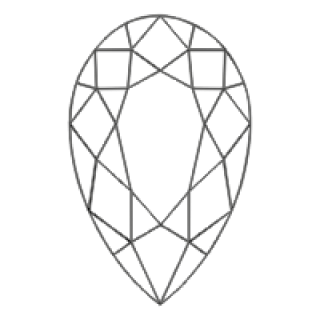
Origin
The first pear cut or the tear drop diamond was created by a Flemish polisher Lodewyk van Berquem of Belgium in 1458 for the influential Valois family. This cut became highly popular during the Renaissance period. The pear shaped diamond has no table , culet or edge but is covered all over with long triangular shaped facets. This shaped diamond bears resemblance to a gleaming teardrop and is best described as being half oval, and half marquise-pear shaped as this stone is pointed at one end and round at the other. Ideally cut pear shapes have 58 facets.
Popularity
This cut is an interesting choice for a multi-faceted personality as its unique shape makes it a popular choice for engagement rings and if chosen in a more elongated pear shape, the length creates a fine slimming effect on the finger. Since pear cut diamonds are designed to maximize brilliance it makes a stunning engagement ring as a solitaire or when set with other stones and thus this cut is becoming more popular in masses day by day.
Celebrities Wearing Pear Cut Diamond
Katherine Heigl, Avril Lavine, and Jessica Simpson are some of the celebrities to have adorned the beautiful princess cut diamond.
Ratio
Every diamond shape has a length-to-width ratio, which concludes as to how a diamond will come into view from above. Ideally, a pear shaped diamond should have an excellent or very good symmetry. The ideal length to width ratio of 1.45 to 1.75 is recommended for this type of cut. At Fascinating Diamonds® we lay stress on precision in measuring a diamond, as well as the length to width ratio, so that you know the exact shape of the pear shaped diamond engagement rings that you are considering.
Cost
The pear shaped diamond like marquise and oval cuts comes in a wide range of slim to wide cuts, and has the added advantage of making the wearer's fingers appear long and slender. This diamond is always worn with the narrow end pointing toward the hand of the wearer. Eventually, the price of this diamond depends upon the carat weight and color grades, for which the customers are willing to shell out a premium price.{' '}
Depth & Table
| Depth (%) | Table (%) | |
|---|---|---|
| Excellent | 58 - 62 | 53 - 63 |
| Very Good | 56 - 57.9 or 62.1 - 66 | 52 or 64 - 65 |
| Good | 53 - 55.9 or 66.1 - 71 | 51 or 66 - 68 |
| Fair | 50 -52.9 or 71.1 - 74 | 50 or 69 - 70 |
| Poor | < 50 or > 74 | < 50 or > 70 |
The Revolutionary: Heart Shape Diamond
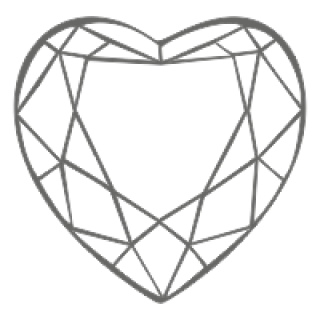
Origin
The heart shaped diamond the ultimate symbol of love and is known as the most romantic of all the diamond shapes. It was first mentioned in correspondence between the Duke of Milan, Galeazzo Maria Sforza, and Nicodemo in 1463. It is said that in the year 1562, Mary Queen of Scots had sent to Queen Elizabeth a gold ring which had a "diamond made like a heart". These specially-designed diamonds were exchanged between royalty for hundreds of years, as a sign of good will and amity. As it was a difficult cut, particularly with the shaping tools used in those times, these diamonds were treasured and valued over other gems. The Heart cut diamond is fundamentally a pear shaped diamond with a cleft at the top. It consists of 58 facets and is full of brilliance and fire.
Popularity
The heart shaped diamond solitaire not only had an ancient and well-known legacy, but also continues to be popular in modern times as well. Staying true to its name the heart-cut diamond has become synonymous with love and affection and conceivably is the most romantic shape for a diamond. The heart shape diamond conventionally serves as the ultimate symbol of love and is a popular choice for anniversary or engagement rings. This diamond upsurges pure emotion of warmth and love. It is due to this that the heart shape diamond solitaire rings have become a popular choice during Valentine’s Day and dates marking relationship milestones.
Celebrities Wearing Heart Cut Diamond
Elizabeth Taylor (17th century Taj Mahal Diamond), Joan Collins, Katherine McPhee, and Carla Bruni are some of the celebrities to have adorned the beautiful princess cut diamond.
Ratio
Every diamond shape has a length-to-width ratio, which concludes as to how a diamond will come into view from above. Heart shaped diamonds come in a variety of silhouettes, from narrow to fat and thus the choice of a particular shape depends on the personal taste and preferences of the buyer. The ideal length to width ratio of 1.00 is recommended for this type of cut, but for heart shaped stones that are to be set in rings a slightly wider cut of about 0.85 to 1.00 are preferred by customers. At Fascinating Diamonds® we lay stress on precision in measuring a diamond, as well as the length to width ratio, so that you know the exact shape of the heart shape diamond engagement rings that you are considering.
Cost
This unique shape of the heart shaped diamond is similar to a pear-cut diamond, differentiated by two rounded edges and a cleft at the top. This cut diamond is in fact, one of the most sought after shapes, and one of the most challenging shapes to create. When purchasing a heart-shaped diamond, it's extremely important to pay attention to quality and to select the highest grade cut one can afford as it takes a very skilled cutter to create a flawless heart-shaped diamond.
Depth & Table
| Depth (%) | Table (%) | |
|---|---|---|
| Excellent | 58 - 62 | 53 - 63 |
| Very Good | 56 - 57.9 or 62.1 - 66 | 52 or 64 - 65 |
| Good | 53 - 55.9 or 66.1 - 71 | 51 or 66 - 68 |
| Fair | 50 - 52.9 or 71.1 - 74 | 50 or 69 - 70 |
| Poor | < 50 or > 74 | < 50 or > 70 |
The Beautiful: Baguette Shape Diamond
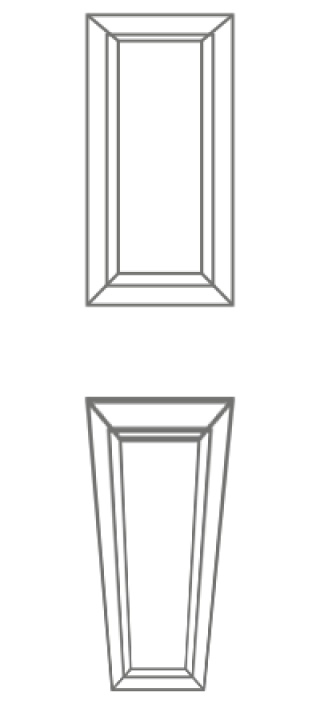
Origin
The baguette cut is a diamond with a step cut which is rectangular shape. The word "baguette" is a French word for a long, narrow loaf of bread. Baguette-cut diamonds gained popularity in the 1920s and 1930s during the art deco and art nouveau movements, which emphasized on geometric form with straight, clean lines. The baguette cut (straight and tapered) is an effortless modification of the emerald cut. A baguette cut diamond traditionally has 14 facets, giving the diamond a high level of luster. These diamonds are used as side stones or in linear sequence to achieve a multifaceted, continuous look.
Straight & Tapered Gaguette
Some of the Baguettes are straight, and are called "straight baguettes," and others are tapered, thus referred to as "tapered baguette" diamonds. A straight baguette is a relatively small, elongated diamond that usually is rectangular in shape. The cut is characterized by square corners with rows of step-cut or step-like facets parallel to the table. A tapered baguette is a relatively small, elongated diamond where the two long sides taper inward to form a long trapezoidal shape. Tapered baguettes are generally set one on each side of a center stone but can be grouped together to form a bigger look. Mixtures of straight and tapered baguettes can be used to create unique jewelry designs.
Popularity
Baguettes are extremely clear and can also be lined up to produce a constant flow of diamonds on a ring, bracelet, or necklace. Baguettes are usually channel-set , but sometimes prong set. This cut is gaining popularity because of its straight, clean lines, and simple geometric form, along with its ideal use as an accent stone. Also, it can be channel set to form curves and other fascinating shapes which make it a versatile cut from a design perspective and that inspires jewelers to create jewelry pieces that would utilize numerous baguette cut stones.
Celebrities Wearing Baguette Cut Diamond
Joe Di Maggio, baseball player proposed to Marilyn with platinum and diamond band set with baguette cut diamond. R&B singer Mary J Blige’s 5 carat round diamond was adorned by a row of baguettes. Angie Harmon’s beautiful round ring was flanked on either side by a baguette diamond.
Ratio
Every diamond shape has a length-to-width ratio, which concludes as to how a diamond will come into view from above. The ideal length to width ratio of 1.5 to 1.00 is recommended for these dazzling and lively shaped stones. At Fascinating Diamonds® we lay stress on precision in measuring a diamond, as well as the length to width ratio, so that you know the exact shape of the baguettes cut diamond rings that you are considering.
Cost
If baguettes are used as side stones or as other matching pairs, they must have similarity in quality, color, and clarity to one another, and to the stone they are embellishing. The step-cut appearance of the baguettes is intolerant to minute imperfections also. The shape and cut of a baguette diamond can reveal more of its flaws and thus a higher quality of baguette is required which by design makes them expensive.


